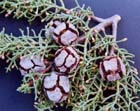
Cones of this variety are unusual in that they open at maturity and release their seeds. These cones were collected near Botela Azul in the Sierra San Pedro Martír [Jeff Bisbee, 2002.07].
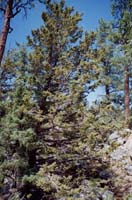
A large mature tree, same site [Jeff Bisbee, 2002.07].
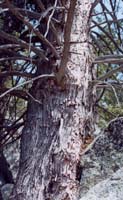
Trunk of a large mature tree, same site [Jeff Bisbee, 2002.07].
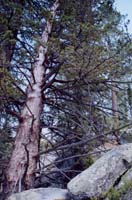
Bark and branching on a large tree, same site [Jeff Bisbee, 2002.07].
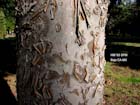
Bark of a tree at Merlin May Arboretum, Oregon [Frank Callahan, 2012].


but see "Distribution and Ecology" below
Hesperocyparis montana
(Wiggins) Bartel 2009
Common names
San Pedro Martír cypress.
Taxonomic notes
Synonymy: see POWO (accessed 2023.12.16). See Hesperocyparis arizonica for discussion of the relationship between various taxa assigned by some authors to H. arizonica. See Hesperocyparis for a discussion of the relationship between this and other, closely related Hesperocyparis taxa in northwest Mexico and the adjacent Southwest U.S.
Description
Trees, 5-20 m tall and 20-50(-100) cm dbh. Branches numerous, spreading, the tips slightly ascending, forming an open to compact pyramidal crown. Bark narrowly ridged, shredding, persistent, deep red to chocolate brown; on younger branches gray-brown, exfoliating in irregular patches to expose smooth light gray-red underbark. Branchlets 8-12(-20) mm long, 1.5-2 mm thick. Leaves not dimorphic; 1-1.5 × 1.5-2 mm when young, acute, with conspicuous, active abaxial resin glands; when older up to 3-4 × 5 mm. Leaf margins lightly fimbriate under a 10X lens. Pollen cones abundant, up to 2 × 3 mm, quadrangular, with (8-)10-12(-14) scales each bearing 3-5 pollen sacs. Seed cones on peduncles up to 10 mm long, at maturity brown or gray-brown, globose to ovoid, up to 30 mm long with 8(-12) scales, umbos 2-3 mm high, broadened or crescent-shaped. Cones open at maturity, shedding 60-70 light tan seeds 3-4(-5) × 3-4 mm, thin, with a light brown 0.5-1 mm long hilum (Wolf 1948). Cones open and seeds are released in October (Jeff Bisbee e-mail 2002.04.06).
Distribution and Ecology
Mexico: Baja California Norte: the Sierra San Pedro Martír, where it is widely but sparsely distributed at elevations of (1900-)2200-2400(-2825) m (Wolf 1948, Farjon 2005).
Data from USGS (1999). See also the detailed map presented by Maerki (2015).
The species conservation status is reviewed by Maerki (2015), who notes that its status was initially cited by the IUCN as "Vulnerable" and in 2013 reassessed as "Critically Endangered" on the basis of a very small extent of occurrence (46 km2) and very small population (less than 250 mature trees). Maerki (2015) notes that this assessment must have been performed without benefit of field visit or literature review, as the number of mature trees is in the thousands and the extent of occurrence is approximately 107 km2, with an area of occupance of about 30 km2, including 9 localities and 91 groves. Moreover, the species occurs in a remote and high-elevation area within a national park, and is at very low risk from anthropogenic disturbances (Maerki doesn't mention it, but the remoteness does not remove the risks of climate change). Based on these data, Maerki finds that the species qualifies as "Endangered" under current IUCN criteria.
Remarkable Specimens
Wiggins (1933) reported "Between Vallecitos and La Encantada are several fine groves, in one of which the largest specimen seen was growing. It was nearly 25 meters high and about a meter in diameter a like distance from the ground." Werner (1951) reports finding a tree "15 feet in girth", i.e. about 145 cm diameter, but does not state the height of measurement.
Ethnobotany
No data as of 2023.12.16.
Observations
Trees are fairly common at exposed sites along the east-facing summit escarpment of the the highest peaks of the Sierra San Pedro Martír, notably on the upper slopes of the Picacho del Diablo. Some occurrences are within dayhiking distance of the road's end, though a trip up the Picacho requires several days. See Abies concolor for further description of the area and how to get there.
Maerki (2015) states that only 23 ex situ collections of this species are known.
Remarks
Citations
Bartel 2009: described in Adams, R.P., J.A. Bartel and R.A. Price. 2009. A new genus, Hesperocyparis, for the cypresses of the western hemisphere. Phytologia 91(1):160-185.
Maerki, Didier. 2015. Note on the conservation status of Cupressus montana. Bulletin of the Cupressus Conservation Project 4(3):133-136.
Werner, Louise T. 1951. On the trail to Picacho del Diablo. Desert Magazine 14(5):4-8.
Wiggins, Ira. 1933. New plants from Baja California. Contributions from Dudley Herbarium 1: 161-164. http://www.cupressus.net/CUmontanaWiggins.html, courtesy of the Cupressus Conservation Project website.
See also
The species account at Threatened Conifers of the World.
Bisbee, Jeff. 2006. Photos at the Cupressus Conservation Project website.





